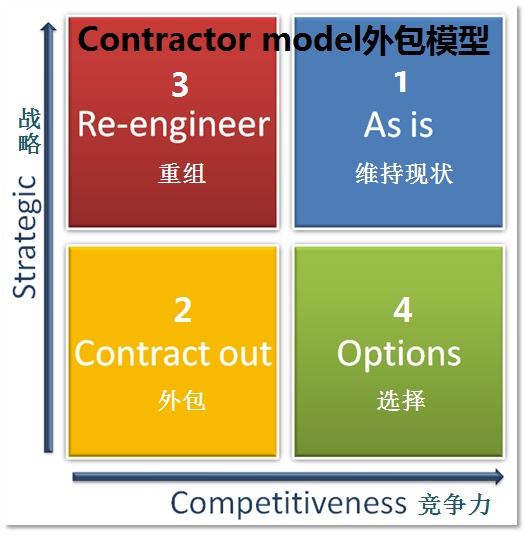Outsourcing model
Contractors are used by many departments to perform asset related work. A set of policies and procedures to guide all contractor related work should therefore be developed for the whole organisation. At lower maturity levels the requirements are mainly driven by Finance from a financial control perspective. All contracts and contractors are also managed in the same fashion. At higher maturity levels contractors and contracts are categorised and managed accordingly. And the contracts are reviewed periodically.
Before we carry on with managing contractors, first a quick look at some reasons for using contractors in the first place.The results shown here are from an AM outsourcing study conducted. A number of organisations were asked to list the reasons why do they outsource certain AM work or functions. The 80% grouping lists the most popular reasons. Ask the delegates on the course to have a look at the 20% list. Although some of the reasons are very valid, some put forward are actually not good reasons for outsourcing. See if the delegates can identify some of these reasons. [reduce management effort; reduce risk; reduce influence of trade unions]
As part of the study the organisations were also asked to comment on why they dont outsource certain AM work. The reasons for keeping it in-house are as follows:
What are the criteria for making an outsourcing decision? Do we do it ourselves, or can we outsource?
 The model presented here is a simple but effective example of the evaluation that should be considered prior to outsourcing work. The two criteria here are:
The model presented here is a simple but effective example of the evaluation that should be considered prior to outsourcing work. The two criteria here are:
How important is this activity to the organisation in achieving long-term competitive advantage in its chosen marketplace?
How competitively (competently) is the function being performed compared to the external competitive marketplace?
Based on the outcomes of these answers, the following can be suggested:
Retain the status quo
Little value in investing to improve this function
Outsource these functions
Should not outsource these functions in the long run
Instead, re-engineer to ensure that they are performed at a competitive cost, quality and speed
Sell the function as a going concern
Extend the function to provide services to external clients
Outsource the function
Raise the profile of the function to turn it into a source of strategic competitive advantage
Should all contracts or contractors be managed in the same fashion?
As with Material Management and Asset Care Plans, we often need to focus our attention to manage the most critical issues the best. In the mentioned KPAs we classified spares and assets respectively in ABC groupings, and them developed an approach per group or ca tegory. The same is recommended for contractors and contracts. Here this part introduces the concept of contractor categories, in this case 4 categories based on criticality and cost of service. The four categories created can be described as follows:
tegory. The same is recommended for contractors and contracts. Here this part introduces the concept of contractor categories, in this case 4 categories based on criticality and cost of service. The four categories created can be described as follows:
Provide high level goods, services or functionality that is not readily available from the market place
Also provides high level goods, services of functionality, but their importance is not apparent from relative low level expenditure
Expenditure may be high but the importance is low when the commodity is readily available
High number of contractors but low expenditure
Important to develop an approach per each of these categories.
Represented here is the typical outcome of grouping an organisation’s contractors/contracts among the categories. Take note that only 2% of the contractors/contracts fall within the strategic group, yet it accounts for 50% of the expenditure.
So where do you start managing contractors more closely?
You start by creating detailed procedures and requirements for the Strategic Group. Once under control, your attention can move to the Specialist or Commodity Groups. As for the transactional group – it only represent 5% of expenditure, so you should get away with limited controls without increasing your risk exposure.